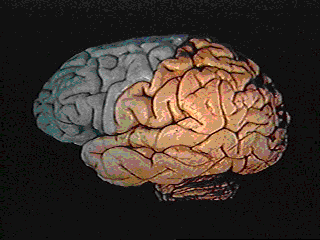SPH405
| Neurological Foundations of Speech, Language and Hearing |
The Corticobulbar Tracts and Normal Human Communication
GOAL: To apply the physiology of the corticospinal tracts to normal human communication:
OBJECTIVES: "After reading, lecture and study, the students will...
Distinguish the corticospinal tracts from the corticobulbar tracts.
Distinguish the anterior corticospinal tract from the anterior corticospinal tract.
tract the course of the corticospinal tracts.
...on the examination with 90+% accuracy."
Pyramidal tracts begin in areas 4 and 6 of the frontal lobe.

The cell bodies of the pyramidal cells (giant cells of Betz) located just below the surface of the cortex.
Axons of the pyramidal cells convey action potentials to the motor nuclei of the cranial and spinal nerves.
The CORTICOSPINAL tracts begin in area 4 of the frontal lobe.
This area is called the "Motor Cortex. It occupies the medial 2/3 of the precentral gyrus. There is a somatotopic arrangement of upper motor neuron cells in the motor cortex. Those cells that supply motor impulses to the upper parts of the body are located in the inferior portion of the gyrus, while those concerned with the lower regions are located in correspondingly more superior precentral regions.
Axons of the UMN's descend to the ipsilateral INTERNAL CAPSULE.
They converge in the anterior portion of the posterior limb.
In the internal capsule area, they are grouped tightly with the axons of the corticobulbar tracts.
Axons pass through the internal capsule and descend into the BRAINSTEM via the cerebral peduncle. They pass through the: Midbrain (Cerebral Peduncle), Pons, and Medulla.
The corticospinal tracts separate into two divisions, depending upon their destinations. One collection is destined to supply the extremities. the other is bound for the trunk and axial musculature.
LATERAL CORTICOSPINAL TRACTS supply motor innervation to the extremities.
At the spinobulbar junction, caudal to the sensory decussation, the fibers destined for the extremities decussate.
This is called the Motor Decussation or the Decussation of the Pyramids.
Most of the corticospinal fibers cross at this point.
Then they descend into the lateral corticospinal tracts.
ANTERIOR CORTICOSPINAL TRACT fibers destined for the neck and trunk (axial muscles) do not decussate here.
Thus, pyramidal fibers of the corticospinal tracts have CONTRALATERAL and UNILATERAL PROJECTION.
Fibers originating in one cerebral hemisphere, innervate the contralateral musculature.
Lateral corticospinal fibers cross at the motor decussation
nterior corticospinal fibers cross at the segmental level
There are some ipsilateral fibers (Hamilton, p..531), but these aren't enough to control a muscle in case of injury.
Interruption of the UMN corticospinal fibers is associated with SPASTICITY.
The mechanism is not clear. Spasticity is characterized by excessive muscle tonus and a hyperactive stretch reflex.
Destruction of the corticospinal tracts is thought to release the muscle from the inhibitory control of the higher cortical levels. Perhaps there is input from some fibers originating in another parts of the cortex which suppress the stretch reflex.
Experiments have shown flaccidity resulting from focused destruction of the tracts originating in the motor cortex.
Spastic muscles won't waste as is the case with severing the LMN's. There will be some disuse atrophy, with its extend depending somewhat upon the rehabilitation program.
In the case of injury of the spinal cord, all function below the segmental level of destruction will be affected. If the injury in to the lateral aspect of the cord, dysfunction any be limited to the extremities. If injury occurs at the bulb or rostral, the effects will extend to entire extremities or trunk areas, depending upon the location and extent of the lesion.
Corticospinal tracts are tested with MUSCLE REFLEX TESTING.
Plantar Reflex Testing. The pathological plantar reflex is the Babinski reflex. When the plantar surface of the foot is stimulated, the toes extend.
Go on to Online Lesson 3
These tracts occupy the posterior portion of the lateral column of the spinal cord.
They synapse with LMN's in the anterior (ventral) horns gray at the segmental level to innervate the extremities.
These fibers decussate at the level of the segment they innervate.
and synapse with the LMN's in the ventral horns gray of the cord.
Stretch Reflex Testing
At Biceps
At Patellar Tendon
Once you have finished you should:
or
Go back to Major Descending Tracts
E-mail Bill Culbertson
at bill.culbertson@nau.edu
Call Bill Culbertson
at (520) 523-7440
Copyright © 1999
Northern Arizona University
ALL RIGHTS RESERVED